Aspects of the Theory of Syntithology
« previous post | next post »
From John Brewer:
Not sure if Language Log typically has a "travel page" section, but those readers in or near the NYC area who are vaccinated or otherwise not locked down might be interested in an exhibit at the Grolier Club in Manhattan that I visited a few days ago and will remain there until mid-May. It's called "Taming the Tongue in the Heyday of English Grammar (1711-1851," and includes sixty-odd different volumes from that time frame offering analysis, instruction, prescriptivist guidance, and/or complete crackpottery on the subject. They are all from the personal collection of the famous and/or notorious Bryan Garner. Admission is free but you need to book a time-slot 48 hours in advance via their website so they can limit the number of visitors to a pandemic-suitable total.
More details here (you may need to click on the "Second Floor Gallery" tab).
John sent three cell-phone photos:
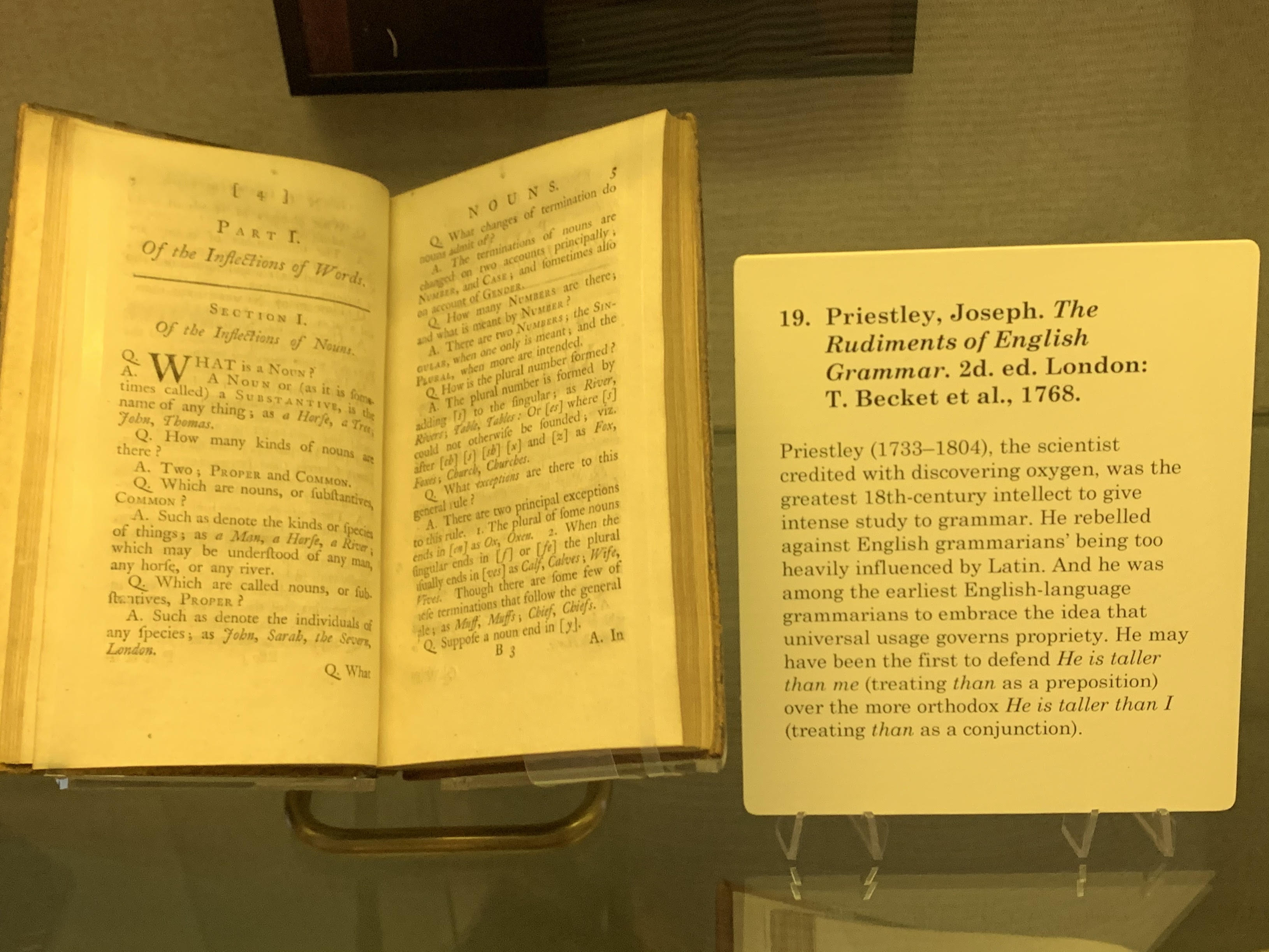 |
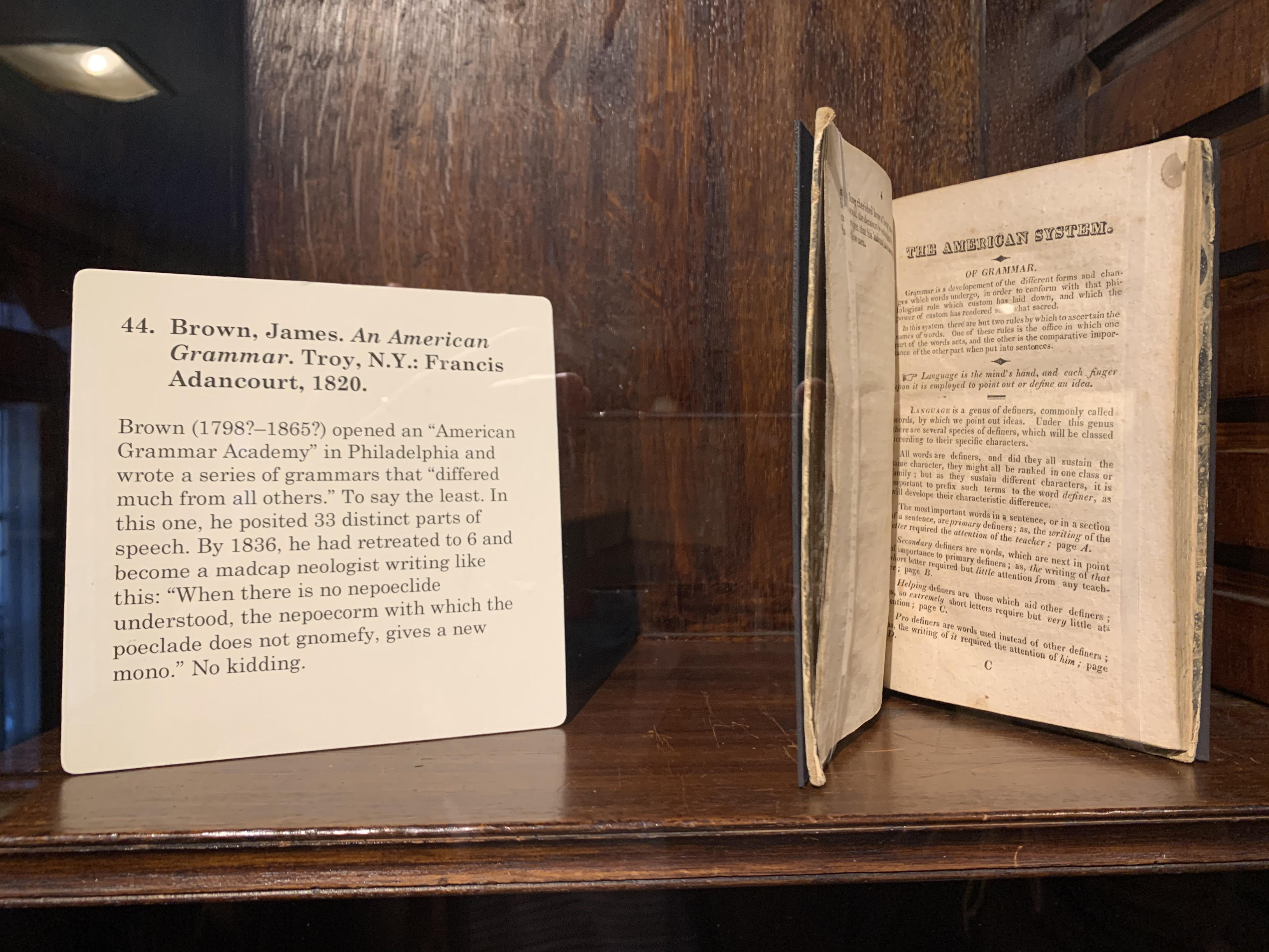 |
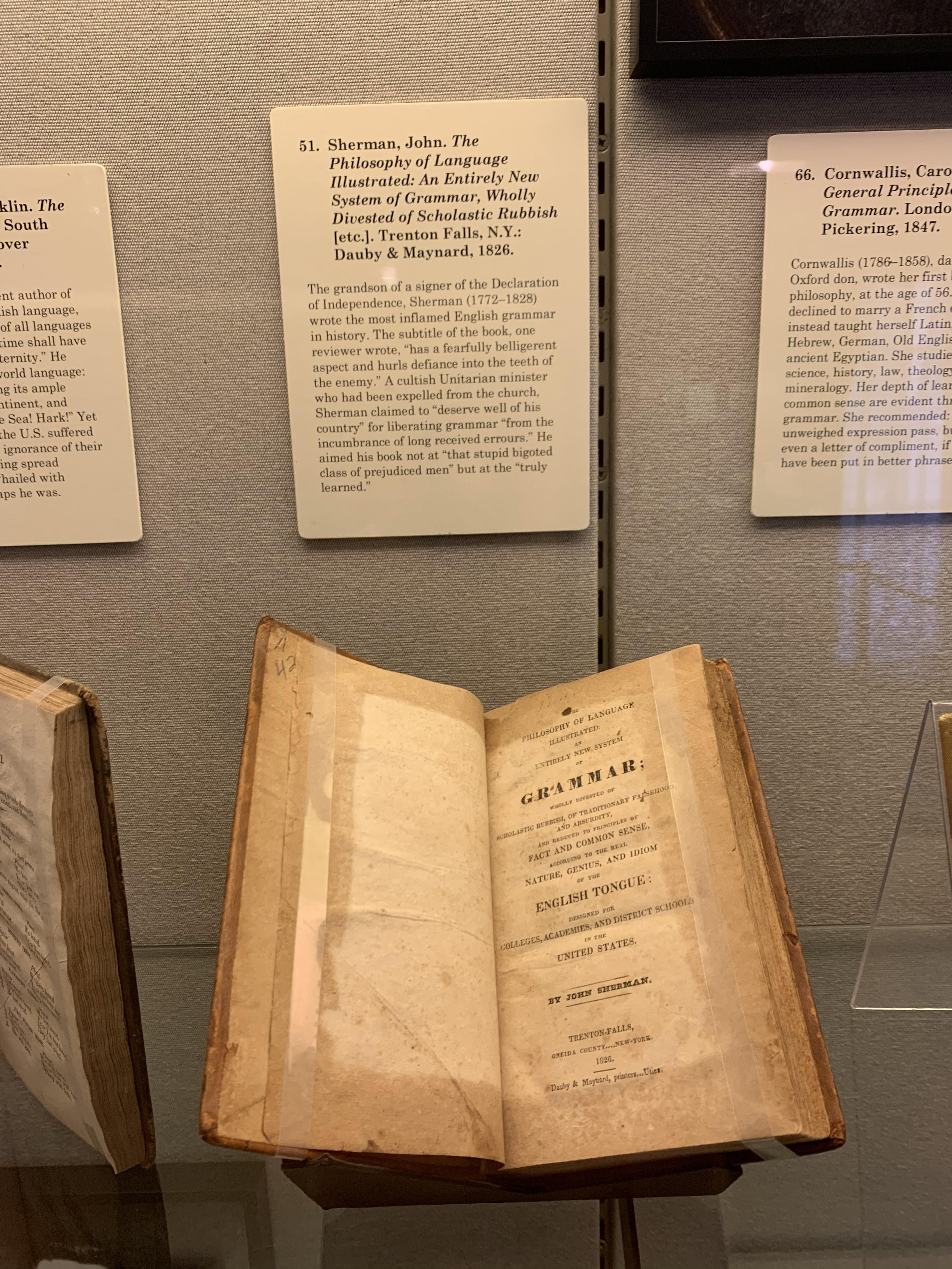 |
I was interested to learn that Joseph Priestley thought and wrote about grammar — and that he apparently had sensible things to say about it, as the exhibit explains:
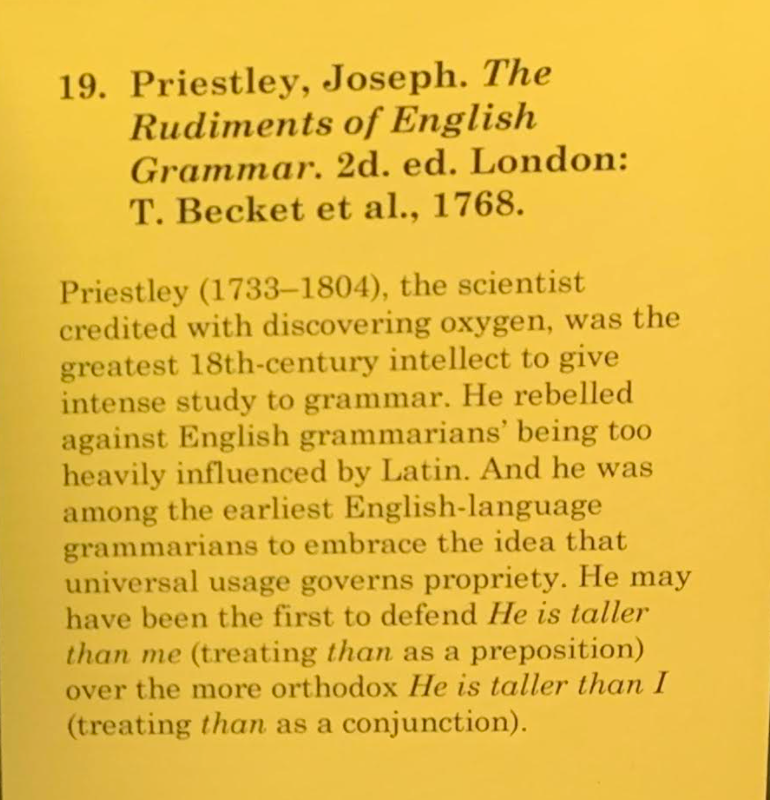
Some day I'll read Priestley's book 1772 book, The Rudiments of English Grammar, Adapted to the Use of Schools, with Examples of English Composition: To which are added, Notes and Observations for the Use of Those Who Have Made Some Proficiency in the Language.
But today I was distracted by the exhibit in John's second picture, featuring the writings of James Brown:
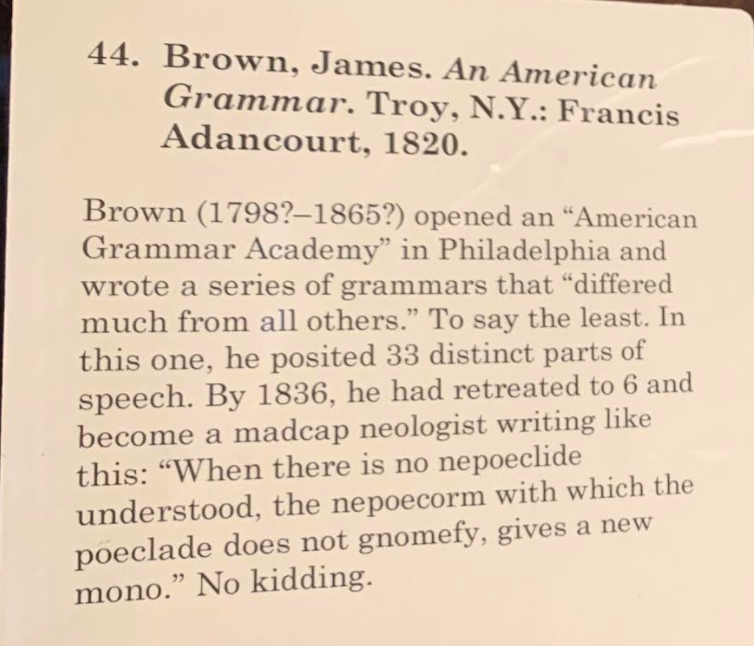
Mr. Brown's ideas never seem to have caught on, for reasons that may become clear as you read him. As evidence for the lack of uptake, he's missing from the long list of James Browns on Wikipedia's James Brown Diambiguation Page.
But this now-forgotten James Brown still managed to publish many editions of many books. Much of the content of these works is polemical invective directed against earlier authors, later authors who ignore him, and those few who took (mostly critical) note of his efforts. Most of the rest is evolution and exemplification of a large distinctive vocabulary of analytic neologisms. Brown's creations are nearly Wilkins-like in taxonomic breadth and depth, though he builds them out of Greek morphemes rather than arbitrary letters.
To whet your appetite, I've quoted a few sample passages from pp. 13-25 of his 1838 work The American System of English Syntax, Developing the Constructive Principles of the English Phrenod or Language, and impressing them on the memory by pictorial, and scenical demonstration, thus enabling the adult at home, and the child at school, to acquire, in a few months, a better knowledge of syntax by the American system than they can ever acquire by the British.
He starts off this way:
PHRENOD is that set of signs, which forms the medium of communication from one mind to another.
(Phren, the mind; and odos, a means, a medium, a way.)
REMARKS. I. Every nation has found it important to have a phrenod, composed of sounds, and a phrenod composed of letters. Hence, each nation has two phrenods; viz. a PHONOD, and an ALPHOD.
(Phone, a voice; and odos, a medium. Alpha, a letter, and odos a means.)
II. The distinctive name of a phronod is generally formed from the national appellation of the people who use it–hence, the phrase, the French phrenod, the Greek phrenod, the English phrenod, &c.
PHRENODY. PHRENODY is the science of phrenods. English phrenody is the science of the English phrenod.
PHRENODY is divided into two parts; namely,
1. SYNTAX, and
2. SIGNOLOGY.
1. Syntax is that part of phrenody, which comprises the constructive principles of phrenods.
2. SIGNOLOGY is that part of phrenody, which comprises the significant principles of phrenods. (Signology is taught by a Dictionary.)
ENGLISH SYNTAX. ENGLISH SYNTAX is that part of English phrenody, which consists of the constructive principles of the English phrenod.
ENGLISH SYNTAX is divided into six parts, viz.
1. GNOMEOLOGY.
2. MONOLOGY,
3. SYNCRATOLOGY,
4. SEMENOLOGY,
5. SYNTITHOLOGY, and
6. POEOLOGY.
Bet you can't wait for the next part!
I. GNOMEOLOGY. GNOMEOLOGY is that part of syntax, which consists of the doctrine of a gnomod, or sentence.
II. MONOLOGY. Monology is that part of syntax, which consists of the doctrine of monos.
III. SYNCRATOLOGY . SYNCRATOLOGY is that part of syntax, which consists of the conjunctive power, and character of words.
IV. SEMENOLOGY. SEMENOLOGY is that part of syntax, which respects the power of a word to distinguish those things to which the Dictionary meaning of the word does not apply.
V. SYNTITHOLOGY. SYNTITHOLOGY is that part of syntax, which consists of the principles of putting words together in the formation of gnomods, or sentences.
VI. POEOLOGY. Poeology is that part of syntax, which consists of the principles of forming words.
And one more bit:
GNOMEOLOGY is that part of syntax, which consists of the doctrine of a gnomod, or sentence.
A gnomod , or sentence . A gnomod, or sentence, is an assemblage of two, or more words, which expresses a cordiction; as,
1. It is nine.
2. If it is nine.
3. Is it nine?
4. Go thou to school.
5. Forgive thou our sins.
A gnomod consists of two things; namely, words , and a cordiction ; as, “ It is nine .”
1. The words are a frame-work of pointers , each pointing to something on which the cordiction has a near, or a remote bearing.
2. The cordíction is the abstract affirmation, the abstract nutation, the abstract interrogation, the abstract command, or the abstract petition which is expressed in the assemblage of words; as, “ It is nine , If it is nine , Is it nine ? Go thou to school , Forgive thou our sins . ”
You can continue the journey on your own, through the cited work or some of Brown's later works, e.g. the 1850 edition of
An English Grammar, in Three Books, Developing the New Science, Made Up of Those Constructive Principles which Form a Sure Guide in Using the English Language; but which are not found in the Old Theory of English Grammar.
And let me note, in conclusion, that it's nice to go places and see things IRL, but these days, digital versions of books published before 1922 are nearly all available on line, and so someone could create a (permanent?) virtual exhibition of (English and otherwise) grammar books back through history.
Update — from The National Gazette, Philadelphia, Pennsylania, Wed. 25 Aug 1830:
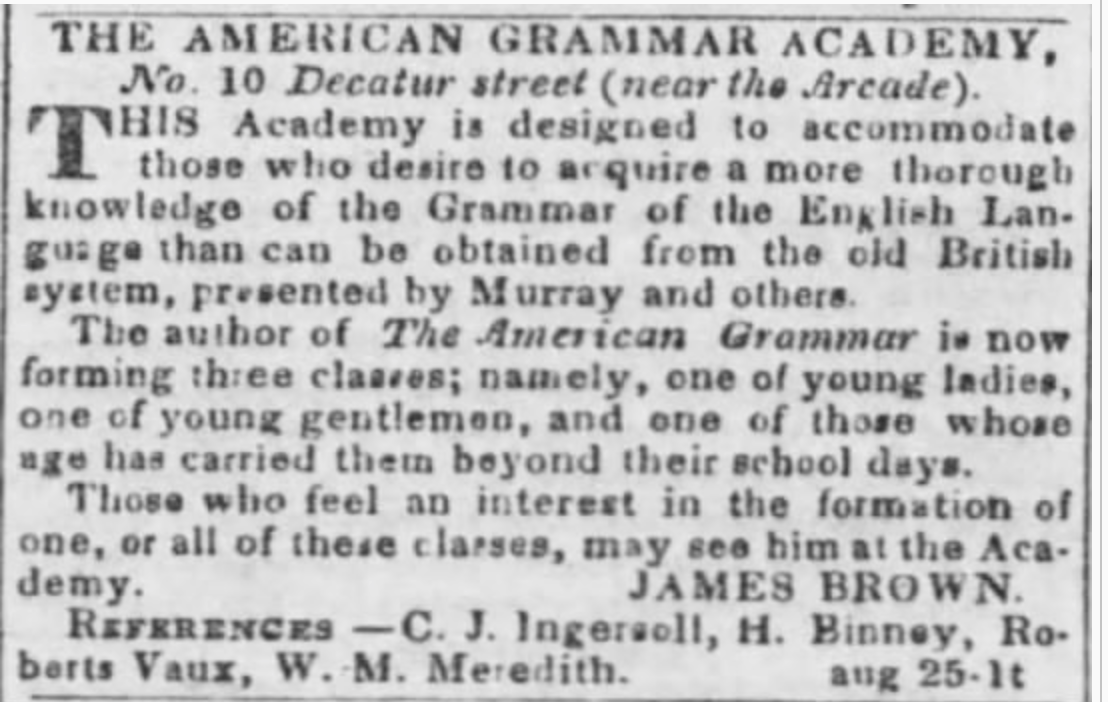
Jerry Packard said,
April 11, 2021 @ 12:47 pm
Wicked good.
If you think about it, most of the systems proposed here have to do with indicating sound and meaning, connecting them via a form (morpheme), arranging them in an order (word formation, syntax), and then how that interfaces with orthography and the culture.
I especially like 'crackpottery.'
[(myl) In Chapter II of the cited work, Brown introduces what may be the earliest explicit "syntax as a tree" metaphor:
ORDER OF MONOS. Monos are divided into two orders upon the principle of their frame-work rank in a gnomod, or sentence. These are
1. GNOMECORME, and
2. CLAD.
1. The gnomecorme is the foundational, the trunk mono in a gnomod, or sentence; as, [ There was a marriage ] (in Cana) (of Galilee.)
NOTE.—The gnomecorme bears the same sustaining relation to the clad in the frame-work of a sentence, which the trunk bears to the branches in the frame-work of a tree.
2. The clad is a branch mono; as, [There was a marriage] ( in Cana ) ( of Galilee . )
NOTE.—The clads bear the same relation to the gnomecorme, in the frame-work of the sentence, which the branches bear to the trunk, in the frame-work of a tree.
]
David Marjanović said,
April 11, 2021 @ 4:19 pm
Poe's law strikes again.
J.W. Brewer said,
April 11, 2021 @ 4:59 pm
I did not spring for the \$45 (cheaper than that for Grolier Club members) catalog of the exhibition, which is a 300-page hardbound volume including contributions by the likes of David Crystal and Lane Greene. But if you might be interested and aren't in a position to swing by the receptionist's desk at the club, you can obtain it directly from the publisher. Or if you have an affiliation with a research library maybe make them spring for it, assuming they haven't been habituated by the pricing policies of Brill et al. to assume that anything as cheap as $45 can't possibly be of scholarly value.
https://www.oakknoll.com/pages/books/135437/bryan-a-garner/taming-the-tongue-in-the-heyday-of-english-grammar-1711-1851
J.W. Brewer said,
April 11, 2021 @ 5:01 pm
[my use of a dollar-sign in the previous post apparently was treated as a non-sensical formatting instruction that created a formatting glitch, and I would be much obliged if the management can undo the inadvertent damage since I can't revise my post to try to fix it]
Roscoe said,
April 11, 2021 @ 5:45 pm
Not to be confused with GNORMECORE, the fashion trend where you pair a conical red cap and belted coat with sweatpants and sneakers.
AntC said,
April 11, 2021 @ 9:49 pm
I was struck by Brown’s use of commas:
XXX is that part of yyy, which …
Usually (these days) comma before ‘which’ indicates an attributive relative; no comma a restrictive relative. [Apologies some grammaricologists frown on those terms.]
Brown’s usage has to be understood in a restrictive sense. Was the convention different in 1838?
Viseguy said,
April 11, 2021 @ 10:35 pm
Oh, this looks priceless! From the "Second Floor Gallery" web page:
Anthony said,
April 13, 2021 @ 7:48 pm
I did spring for the volume (edition of 950), being a linguist and my father having been an enthusiastic member of the Grolier Club. What I know of old grammars of English comes from SPE, so this may be an eye-opener.